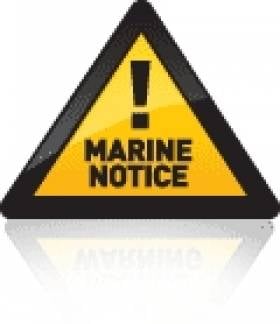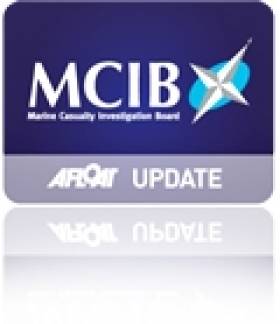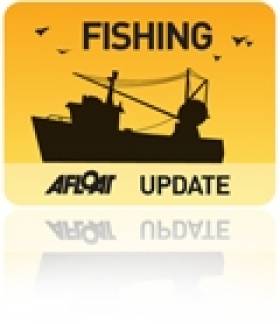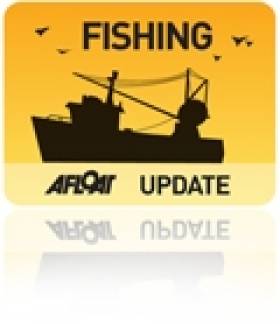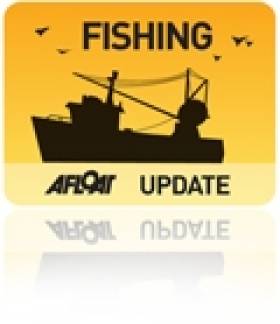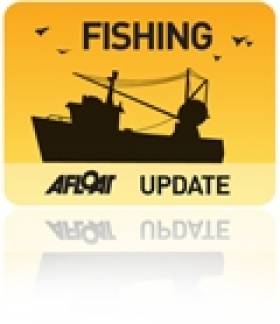Displaying items by tag: Fishing
International Fisheries Negotiations Hosted By Ireland
#fisherynegotiations – Ireland, on behalf of the European Union, is hosting important fisheries negotiations between Norway, Sweden, Denmark, Germany, Netherlands, Belgium, France, United Kingdom, Spain, Portugal and Ireland at the National Seafood Centre in Clonakilty, Co. Cork. These negotiations, on the annual fishing arrangements for 2015 between the European Union (EU) and Norway, commence at the National Seafood Centre in Clonakilty on Monday the 1st of December.
Minister Simon Coveney stated "I very much hope that we will have a successful outcome on the exchange of fishing quotas and access arrangements which will enable the finalisation of quotas for other stocks such as Blue Whiting off the north west of Ireland and the Herring in Norwegian waters which are of major importance to our west coast pelagic fishing fleet and fish processing plants in Donegal. My delegation will be pursuing Ireland's interests to the utmost during the talks."
Over seventy delegates from across Europe and Norway will meet at the National Seafood Centre in Clonakilty for the week long talks.
These negotiations cover a wide range of fish stocks across the North East Atlantic which are jointly managed by and shared between Norway and a range of EU Member States.
Economically, these negotiations are amongst the most important for the EU fishing industry, and this final round will focus on setting Total Allowable Catches for 2015 for a range of stocks, the sharing of these stocks between the parties and substantial quota swops between the EU and Norway as well as access arrangements to each of the respective areas for the parties. The outcome has a very direct effect on the opportunities available to Irish fishermen in 2015.
The Minister went on to say that "Once again, the National Seafood Centre in Clonakilty is the venue of choice to host these important international talks and helps in the overall aim of emphasizing Ireland's positive and proactive role within the European Union. Over seventy international delegates arriving in Clonakilty for a week in December will also bring a welcome boost to the local economy".
Marine Notice: Site Investigation Works At Rossaveal Fishery Harbour Centre
#MarineNotice - The latest Marine Notice from the Department of Transport, Tourism and Sport advises that site investigation works are being carried out at Rossaveal Fishery Harbour Centre on Galway Bay.
The work comprises drilling multiple boreholes at a series of locations, subject to minor variations, as listed in Marine Notice No 65 of 2014, which is available as a PDF to read or download HERE.
Work was expected to begin on Monday 24 November and is set to finish on or around Friday 12 December, weather permitting. A jack-up barge will be moved to the various borehole locations by a tug-boat, and will remain on site overnight during the operations.
All appropriate lights will be displayed by the barge at night. Radio warnings will be transmitted on VHF Channel 16 throughout the works.
Lack of Lifejacket Key In Lobsterman's Death Says MCIB Report
#MCIB - Wearing a personal flotation device could have helped save the life of a fisherman whose body was found at the Saltee Islands off Co Wexford this summer months after his disappearance, according to marine accident investigators.
As RTÉ News reports, the body of Paddy Barry, 56, was discovered on the shore of Great Saltee Island on 4 May more than five months after his fishing vessel, the MFV Leonora Jacinta, was found south of the island with no one aboard on 25 November 2013.
The official report into the incident by the Marine Casualty Investigation Board (MCIB) established that Barry, a part-time fishermen who could not swim, had set out from Kilmore Quay alone on the morning of his disappearance to lift and bait lobster pots, and retrieve a string of fouled pots close to Shoal Rock.
It was at the latter location where his boat was last seen headed at 11am, but around 11.50am a passing fishing vessel noted that Barry's boat had been stationary in that spot for some time.
Another vessel approached some 30 minutes later and found that the Leonora Jacinta was secured to a line of pots with its engine idling and its pot hauler set in neutral.
Lifeboat and coastguard teams were contacted immediately and began what became a 26-day search by land, sea and air around the area where the Leonora Jacinta was found, but the operation was stood down on 22 December due to deteriorating weather conditions.
According to the MCIB report, witnesses familiar with Barry confirmed that two personal floatation devices (PFDs) found on the Leonora Jacinta were the vessel's only PFDs – and indicated that Barry preferred not to wear one when he was working, against the Code of Practice for Fishing Vessels.
It was also found that the boat's gunwale was only half a metre high at the pot hauler, giving little stability in that deck position. Though not against regulations, it suggests that Barry could have been pitched overboard by the vessel lurching in even a slight swell.
In such an event, strong currents in the area could have carried Barry some two miles northeast of the boat within two hours, and lacking a lifejacket it would have been extremely difficult both for him to stay afloat and for rescuers to spot him.
Had he been wearing a PDF "it is likely that he would have remained on the surface and been visible to the search teams, which could have led to an early recovery," says the report – which also recommends amending the Code of Practice to set a minimum height for bulwarks, guard rails and hand rails.
The full MCIB report on the MFV Leonora Jacinta incident is available to download below.
MCIB Issues Report On Fisherman's Death By Head Injury On 'FV Liberty'
#MCIB - Poor adherence to various safety regulations made worse the situation in which a fisherman died of severe head injury off Cork in February last year, according to an official report into the incident.
As previously reported on Afloat.ie, the man was one of three crew on the fishing trawler FV Liberty that was hauling cod off the Old Head of Kinsale when the tragedy occurred on the evening of Thursday 14 February 2013.
The Marine Casualty Investigation Board's (MCIB) report into the incident details the sequence of events that led to the fatality, which was caused by the failure of split links in the vessel's hauling gear as a cod trawl net was being hoisted, striking the casualty on the head.
It was determined by the MCIB that the ropes and links used on the vessel were prone to jamming and the boat's head blocks were in poor condition - and that the incident may have been avoided if these were properly examined and maintained.
It was also found that none of the three crew had undergone basic safety training, and that none was wearing protective headgear on deck.
While the skipper was an experienced fisherman, he was new to this particular vessel. The casualty, too, had only joined the vessel that day, while the third crew member tasked with operating the lifting gear "would not be considered sufficiently experienced to conduct such a task".
Moreover, the vessel's radio equipment was found to be in poor condition, making communication with emergency services challenging.
Above all, the MCIB states that the vessel "did not comply with the requirements of the Fishing Vessel Code of Practice.
"The deficiencies in place on-board FV Liberty during the MCIB investigation showed that risk assessment was not completed, annual inspection was not carried out for lifting equipment, and personnel had not completed the required training."
The full MCIB report into the FV Liberty incident is available to download below.
'We Belong To Greystones - And Greystones Is A Fishing Town' Says New Campaign Group
#GreystonesHarbour - As recently reported on Afloat.ie, Wicklow County Councillor Derek Mitchell has made the case for the end of commercial fishing at Greystones Harbour, the future of which is "to be a leisure harbour and visitor destination, not a fishing port." But this was news to new campaign group Save Greystones Fishing Fleet, on behalf of whom Laurel Fiszer Storey writes here about what they maintain is the short-sightedness of abandoning the town's longstanding fishing heritage - and its future generations of fishermen...
It is strange to hear of a change of use of Greystones Harbour, which was not made clear to the public during the planning process, until Fine Gael Councillor Derek Mitchell decided to unveil it to us now. Assuredly, the majority of the community of Greystones will be surprised to hear that Cllr Mitchell has decided to change the nature of their town – a fishing village – with an unbroken cultural heritage of fishing traditions dating back several hundred years, to a ‘leisure port.’
This intended change of use most certainly wasn’t made clear in the Wicklow County Council Environmental Impact Survey prior to the development which states: “After the completion of the project, the Harbour will be more accessible from both mainland and sea… The potential for the area to redevelop its commercial fishing industry will be improved due to the increased accessibility of the Harbour to fishing boats” (EIS, p106).
And again: “The expansion of the Harbour will give increased berthage and the basin will be dredged to allow for the ease of movement of fishing and recreational vessels. The upgrading of the harbour could accommodate a higher number of fishing vessels which creates the potential for increased commercial activity in the Greystones Harbour area. The increase in commercial activity has the potential to have a significant positive effect on the economy of the area.” (EIS, p100).
So it may also come as a surprise to Fine Gael TD Simon Harris, who stated in September that he would “…urge Wicklow County Council to work with the local fishermen to ensure that the new by-laws allow them to continue to make a living in our town.
"Common sense must prevail and resolve this matter quickly," he said, remarking on the introduction of the harbour bylaws.
Greystones Harbour is big enough to accommodate fishing boats, which is evident from the Wicklow County Council EIS: the one boat owner working full-time out of the harbour when the development commenced shall be accommodated and so should any fishing boat belonging to any person who wishes to fish out of their local harbour. As local fishermen, they have been accommodated here in this fishing community for centuries. Fishing, by nature is generational. Young people – future skippers – work on boats and learn and earn until they have either inherited a boat or saved enough to buy their own.
One of these men was working on that same Greystones boat (‘that should be accommodated’) in Greystones when he was younger. He has now saved enough to buy his own boat and bring it to Greystones, where his family has lived for generations. It simply did not occur to him that his boat would be rejected.
The owner of the last Greystones boat also has a young son and other younger men with their own families working for him. What if they want to run their own boats - will they be rejected too? And what about the local fishermen who lease boats to fish? They should also be accommodated in their own town.
This is how a tradition is passed down, how it grows and provides employment. Anything else is against economic growth, competition and good sense. What if the same reasoning was applied to coffee shops in Greystones pre- and post-development? Or barbers? Or yachts? How many yachts were ‘accommodated’ before the development? Cllr Mitchell’s reasoning on this point is inaccurate, illogical and irrelevant.
The growth in the fishing industry and number of boats in Greystones is not only testament to the viability of the existing fishing grounds and the potential for growth in the commercial fishing industry in the town, but boats also have jobs available, and those jobs belong to Greystones, as do the skills, traditions and heritage of the men on board.
We have such an incredible opportunity here in Greystones for an integrated, functional, attractive and lucrative public amenity, inclusive of yachts, rowers, anglers, watersport enthusiasts, day-trippers and fishermen. Such an amenity naturally attracts tourists who are not only coming to see the yachts, they are coming to for the character of the fishing community: the seaside feel, the fish and chips and gourmet seafood, the seals eating bait fish, the walks, the views, the smells and the ambiance – the cultural heritage.
We have a massive opportunity here if we can work together. One lone fishing boat may not bring enough revenue to pay for the amenities needed to maintain the fishing section of the harbour: electricity points, fresh water, secure storage, waste removal, and access points. However, the more revenue the boats can earn and support each other the better able they are to maintain these areas when they work together with the council.
Naturally, a private company contracted to manage a private marina gains little or no financial benefit from acting as harbour manager to commercial fishing boats. This suggests a conflict of interest with regards to the management of the public and private usages of space. Maybe we need a neutral harbour master to manage this reasonably?
We also have an opportunity to put in the right amenities now to allow the fishermen to operate in a clean, tidy and efficient manner, and to land and distribute fish efficiently. We would urge Wicklow County Council in partnership with the developer to do so immediately.
One way or another, the Greystones fishermen, their families and traditions will continue in Greystones Harbour. Yet they would surely prefer to be out at sea working than having to fight for the right to the use of a public amenity and to safeguard their livelihoods and heritage for future generations.
New Tech Uses Satellite Mapping To Detect Illegal Fishing
#Fishing - Illegal fishing may have just got a little more difficult thanks to a new marine science project backed by Google that aims to map commercial fishing activity around the globe in near real time.
According to The Verge, the Global Fishing Watch system – launched at the IUCN World Parks Congress in Sydney, Australia last week – uses satellite mapping data from SpaceQuest plugged into specialised software from SkyTruth that allows users to track the activity of thousands of fishing boats across the world's oceans.
Wired goes into greater detail on the revolutionary system, which employs complex algorithms to find the most likely patterns of behaviour, from movement to radio usage, that identify a boat as being engaged in fishing.
Using data from 2012 to 2013, the system filtered billions of AIS radio messages sent by over 100,000 ocean-going vessels down to some 25,000 boats that bore the strongest signs of fishing activity - and determined that over 3,000 of those were indeed fishing vessels.
Marine conservation group Oceana, which has led the Global Fishing Watch initiative, says that once the system is ready to handle live data, it will be able to track fishing fleets and individual ships to within a few days – allowing for law enforcement to act if potentially harmful activity is detected.
And the public at large will be able to view the maps in their web browsers, and contribute towards identifying the most likely culprits of illegal fishing.
Wired has much more on the story HERE.
Sampling Of Northwest Herring Spawning Grounds
#Fishing - The Marine Institute intends to obtain samples of spawning herring at the Bills of Achill this month, and the Glen Head/Aranmore area in December.
The samples will be taken during spawning time. These samples are urgently required to assess the extent of mixing of Irish-spawned herring in VIa, particularly VIaN (West of Scotland).
They will be used in a discriminant analysis of herring caught during the summer acoustic survey, taking place West of Scotland and Ireland. The analysis is a matter of urgency because the stocks are subject to a new ICES assessment in 2015.
Currently, herring in VIaN are considered to be part of a separate stock. However preliminary analysis by the Marine Institute suggests a component of herring in VIaN in summer belong to the NW Irish stock.
Authorisation has been received to allow two pairs of pelagic RSW vessels to enter the 12-mile territorial limits, and to fish herring on these known spawning grounds, on one occasion off Mayo and one off Donegal.
The vessels are the FV Olgarry and FV Pacelli, and the FV Felucca and FV Genesis II. These vessels will be fishing against their existing NW herring quotas, and are not being awarded any additional scientific quota for the exercise.
#Fishing - Marine Minister Simon Coveney yesterday (10 November) held a bilateral meeting with the new French Fisheries Minister Alain Vidalies in Brussels.
The meeting was organised to prepare for negotiations on the 2015 fish quotas which will be decided at the Fisheries Council on 15 and 16 December.
This was the first meeting between Minister Coveney and Minister Vidalies.
“France and Ireland have important shared fisheries in the Celtic Sea," said Minister Coveney. "I met Minister Vidalies to discuss with him the issues of importance relating to the management of these fisheries.
"I pointed out that the Irish and French fishing industries have a strong working relationship and that I wanted to ensure that this relationship is fully reflected at political level.”
The minister added: “There are particular issues arising in the Celtic Sea and our industries have worked together to bring forward measures to increase selectivity and reduce discarding of young fish. The EU Commission has proposed very severe quota cuts to the key cod and haddock fisheries.
"I agreed with Minister Vidalies that we will work closely over the coming weeks to secure agreement to a package of measures involving improved selectivity measures and set quota levels that take into account the most up to date scientific advice.“
The EU Commission has published its proposals for Total Allowable Catches and quotas for 2015. The commission has proposed a 64% quota cut for Celtic Sea cod for 2015 and a 41% cut for haddock in the Celtic Sea. The EU Commission has yet to make its proposal for the Celtic Sea whiting and prawn quotas for 2015.
Submissions from all stakeholders have been sought by 21 November to inform a Sustainability Impact Assessment which will be presented to the Oireachtas by Minister Coveney on 2 December.
MSO Appointing Panel For Surveying Small Fishing Vessels
#Fishing - The Marine Survey Office (MSO) of the Department of Transport, Tourism and Sport wishes to appoint a panel of surveyors to conduct surveys of fishing vessels of less than 15m length overall, in accordance with a Code of Practice for such vessels.
To register your interest for this panel, and to obtain any additional information, see the posting on the eTenders Public Procurement website HERE.
Details of the request for applications are also included in the annex to Marine Notice No 61 of 2014, a PDF of which is available to read or download HERE. The closing date for completed applications is 14 November 2014.
Applications For 2015 Oyster Dredge Licences
#Fishing - Fishermen wishing to apply for oyster dredge licences for the 2015 season must apply on the official form to the relevant River Basin District Office before 12 noon on Monday 17 November 2014.
Inland Fisheries Ireland (IFI) says this process became necessary due to the fact that there are many SACs and Natura 2000 sites in Ireland that also contain oyster fisheries.
As the exploitation of these fisheries will requires dredging, appropriate assessment of these fishing activities will have to be undertaken.
In the absence of appropriate assessments, against predetermined conservation objectives, it is necessary to ensure that no intensification of the fishing activity for oysters be permitted.
This has been further strengthened by the issuing of a direction from the Minister in accordance with Section 278 (5)(a) of the Fisheries (Consolidation) Act 1959 as amended and the Habitats Directive as transposed by European Commission (Birds and Natural Habitats) Regulations 2011 (SI 477/ 2011).
For further information, details on the official application procedure and the application form, visit the IFI website HERE.



























